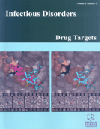- Home
- A-Z Publications
- Infectious Disorders - Drug Targets (Formerly Current Drug Targets - Infectious Disorders)
- Previous Issues
- Volume 16, Issue 1, 2016
Infectious Disorders - Drug Targets (Formerly Current Drug Targets - Infectious Disorders) - Volume 16, Issue 1, 2016
Volume 16, Issue 1, 2016
-
-
EBV-Related Malignancies, Outcomes and Novel Prevention Strategies
More LessAuthors: Oluwatobi Ohiole Ozoya, Lubomir Sokol and Samir DaliaBackground: Epstein Barr Virus (EBV) is a common gamma herpes virus with a high prevalence in adults worldwide. Infection is mostly latent in affected individuals. EBV has been linked mostly with lymphoid malignancies but its association with epithelial and other non-lymphoid malignancies has also been described. Methods: Using MEDLINE, the terms “Epstein Barr Virus AND Malignancy”; “EBV mechanisms”; EBV treatment Read More
-
-
-
Prosthetic Joint and Orthopedic Device Related Infections. The Role of Biofilm in the Pathogenesis and Treatment
More LessAuthors: Suresh Antony and Yvette FarranProsthetic joint infections (PJI) in orthopedic related devices (ORD) are major issues following replacement of joints. It results in serious morbidity and mortality and is expensive to treat and manage. The pathogenesis of these infections is related to the presence of biofilm on the metallic and plastic surfaces of the devices. This biofilm results in poor penetration of antibiotics resulting in persistence and difficulty in eradication o Read More
-
-
-
Bacterial Multidrug Efflux Pumps of the Major Facilitator Superfamily as Targets for Modulation
More LessCausative agents of infectious disease that are multidrug resistant bacterial pathogens represent a serious public health concern due to the increasingly difficult nature of achieving efficacious clinical treatments. Of the various acquired and intrinsic antimicrobial agent resistance determinants, integral-membrane multidrug efflux pumps of the major facilitator superfamily constitute a major mechanism of bacterial Read More
-
-
-
Evaluation of Antimicrobial and Antiviral Activities of Different Venoms
More LessBackground: Animals’ venomous secretions or peptides obtained from those secretions are used in the development of new therapeutic agents. The aims of this study were to investigate antimicrobial and antiviral activity of four different venoms obtained from the frog named Bufo arenarum and the snakes Crotalus atrox, Causus rhombeatus and Naja melanoleuca. Methods: Antimicrobial activities of the venoms tested agains Read More
-
-
-
Study of Common Bacterial and Fungal Pathogens in Children with Hematological Malignancies during Febrile Neutropenia: Single Center Egyptian Study
More LessAuthors: Adel A. Hagag, Samir M. Hassan, Mohamed A. Elgamasy and Ibtesam K. AfifiBackground: Infection ‘is a common complication in children with hematological malignancies’ during febrile neutropenia. ‘Objective: The aim of this study was to’ evaluate common bacterial and fungal pathogens in children with hematological malignancies during febrile neutropenia in single center Egyptian study. ‘Patients and Methods: This study was carried out on 90’ children with hematological malignancies during febrile Read More
-
-
-
Echinocandin Susceptibility Profile of Fluconazole Resistant Candida Species Isolated from Blood Stream Infections
More LessAuthors: Sachin C. Deorukhkar and Santosh SainiBackground: Over the last two decades, Candida blood stream infections (BSIs) have been increasingly reported from various parts of the world. Recent studies on invasive candidiasis have documented the emergence of non albicans Candida (NAC) species as major pathogens. Candida spp. belonging to NAC group often demonstrate intrinsic or acquired or both resistance to fluconazole which is the most readily available and Read More
-
-
-
Severe Adenovirus Pneumonia Followed by Bacterial Septicaemia: Relevance of Co-Infections in Allogeneic Hematopoietic Stem Cell Transplantation
More LessInfections are one of the major complications after allogeneic stem cell transplantation (allo-SCT). Disseminated infections with human adenoviruses species A, B or C are associated with a lethality of 24 to 36 %. Fatal outcome is usually observed with high viral loads in blood (median peak HAdV DNAemia 108 copies/mL). Here we report two adult patients with disseminated infection with human adenovirus C2 after allo Read More
-
Volumes & issues
-
Volume 25 (2025)
-
Volume 24 (2024)
-
Volume 23 (2023)
-
Volume 22 (2022)
-
Volume 21 (2021)
-
Volume 20 (2020)
-
Volume 19 (2019)
-
Volume 18 (2018)
-
Volume 17 (2017)
-
Volume 16 (2016)
-
Volume 15 (2015)
-
Volume 14 (2014)
-
Volume 13 (2013)
-
Volume 12 (2012)
-
Volume 11 (2011)
-
Volume 10 (2010)
-
Volume 9 (2009)
-
Volume 8 (2008)
-
Volume 7 (2007)
-
Volume 6 (2006)
Most Read This Month
Article
content/journals/iddt
Journal
10
5
false
en


